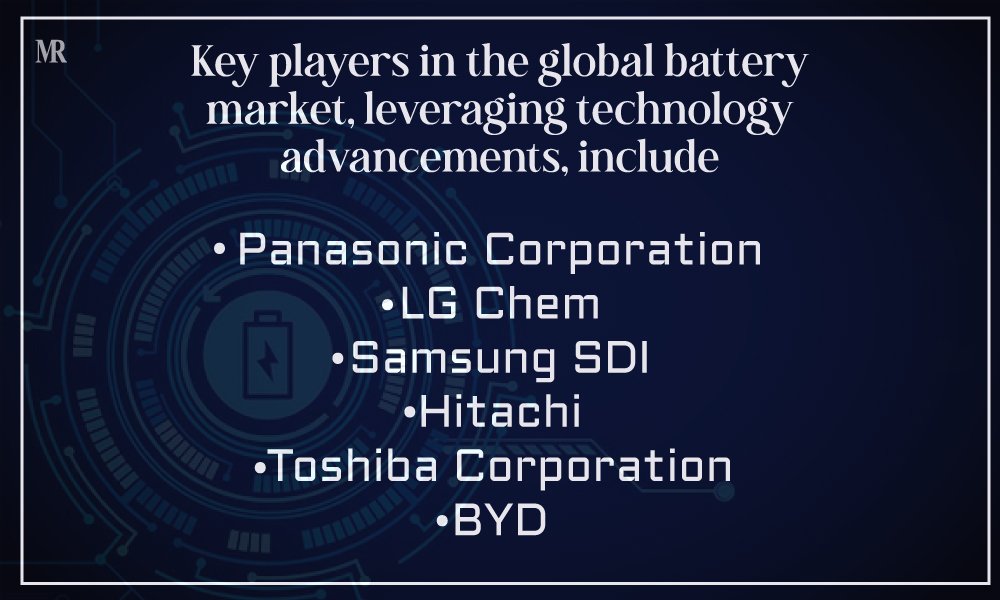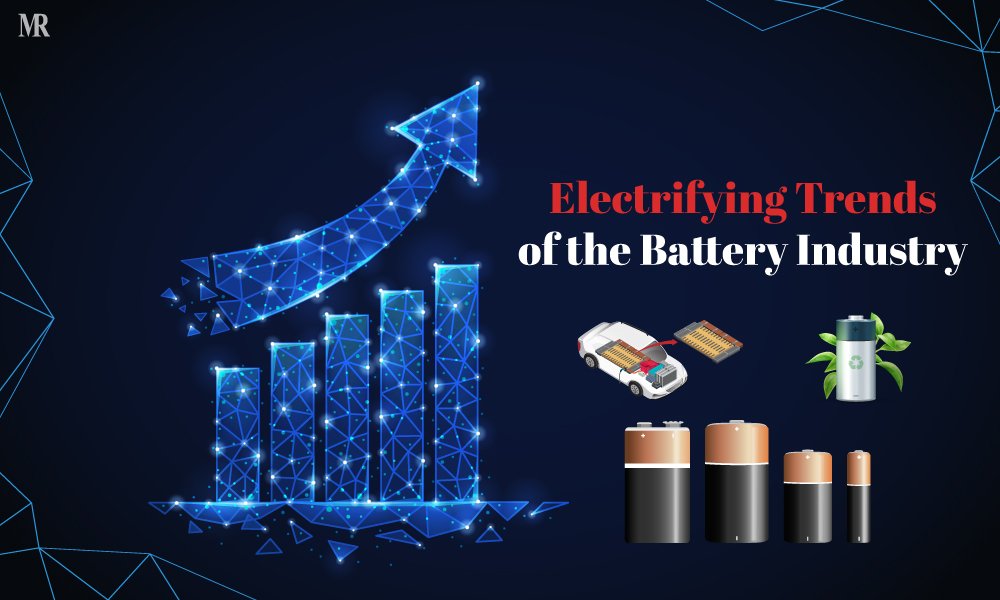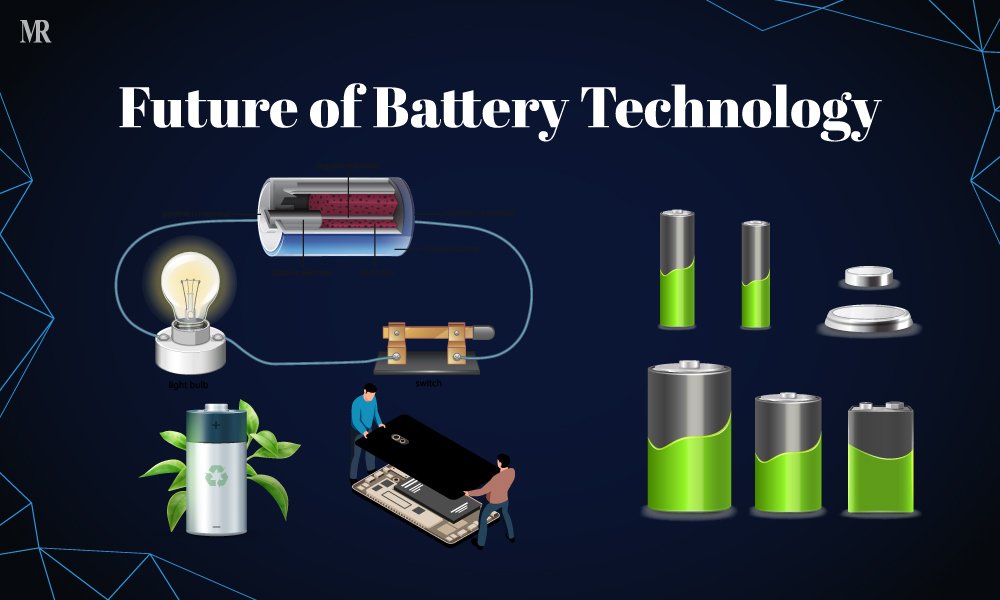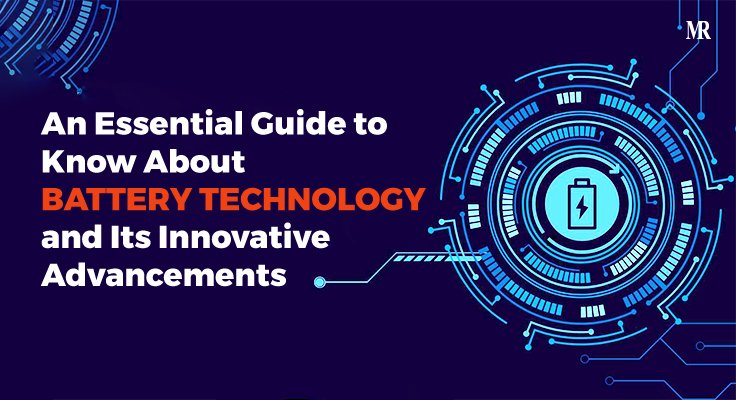Battery technology revolutionized modern life, offering portable energy for gadgets, electronics, electric cars, and renewable energy storage. Advancements in capacity, efficiency, and safety have been significant, driven by ongoing breakthroughs. Key goals are strengthening energy density, extending battery life, and enhancing safety. This progress enables eco-friendly solutions, reducing fossil fuel dependence and mitigating climate change impacts. The quest for more powerful storage continues, from lithium-ion to solid-state, shaping a sustainable future.
Battery Industry at a Glance
The global battery industry is experiencing rapid growth, projected to be valued at $424 billion by 2030. This expansion is propelled by factors such as the surging demand for electric vehicles (EVs), the growth of the renewable energy sector, and the need for energy storage solutions. Among the various segments, lithium-ion batteries, a prominent battery technology, stand out as the most extensive and fastest-growing global battery market. They find applications in EVs, laptops, smartphones, and power tools. Significant international battery market segments include lead-acid, nickel-metal hydride, and sodium-ion batteries. Lead-acid batteries, widely used in cars, trucks, and UPS devices, coexist with other battery technologies. Nickel-metal hydride batteries power some EVs, hybrid vehicles, laptops, and portable devices. While still in development, sodium-ion batteries, another emerging battery technology, show promise of being more efficient and cost-effective than lithium-ion batteries.
The global battery market will reach $178.3 billion in 2023, up from $112.1 billion in 2021, with the lithium-ion battery segment accounting for 57% of the market. The surge in demand for lithium-ion batteries, a key battery technology, is propelled by the increasing adoption of EVs, with the global EV market projected to reach 12.3 million units in 2023, up from 3.2 million units in 2021. The growth of the renewable energy sector further fuels the need for batteries, as global solar and wind power capacity is anticipated to reach 2,300 GW in 2023, up from 1,200 GW in 2021. Developing new battery technologies like sodium-ion batteries also creates fresh market opportunities, while the rising demand for energy storage solutions drives overall market growth.

Battery Types and Market Valuation
Every gadget in the market runs on a specific battery. As battery technology kept evolving, so did the devices. Thus, the battery market is divided into Primary and Secondary. Both types are utilized according to their capabilities. Primary batteries belong to first-generation battery technology, which are still widely used in several devices with less energy need. Secondary batteries are the upgraded technology installed in heavy or multi-purpose devices. Let’s explore them with their market valuation and growth predictions.
- Primary Batteries
Primary batteries, which are non-rechargeable and disposable, play a significant role in powering various devices. Alkaline, carbon zinc, and silver oxide batteries are the most commonly used. The primary battery market is witnessing substantial growth, driven by the increasing demand for portable electronic devices, the rising popularity of electric vehicles, and the growing need for batteries in industrial applications. The global primary battery market was valued at $16.4 billion in 2022 and is projected to reach $21.97 billion by 2027, with a compound annual growth rate (CAGR) of 7.02%.
Asia Pacific leads the primary battery market, followed by North America and Europe. Major players in the industry include Energizer Holdings, Inc., Panasonic Corporation, Sony Corporation, Johnson Controls International PLC, and Duracell International. Some noteworthy statistics about primary batteries have an average 1-2 years lifespan. Alkaline batteries, the most common type, find applications in flashlights, remote controls, and toys. Carbon zinc batteries are less expensive but have a lower energy density compared to alkaline batteries. On the other hand, silver oxide batteries offer a higher energy density but come at a higher cost.
- Secondary Batteries
Rechargeable secondary batteries find widespread use in devices like laptops, smartphones, and electric vehicles. Common types include lead-acid batteries, nickel-metal hydride batteries, and lithium-ion batteries. The secondary battery market is substantial and growing. It is valued at $79.56 billion in 2022 and is projected to reach $89.32 billion in 2023, with a CAGR of 12.3%. Furthermore, it is estimated to reach $137.69 billion by 2027, with a CAGR of 11.4%. The market is driven by the increasing demand for portable electronic devices, the rising popularity of electric vehicles, and the growing need for batteries in industrial applications.
Asia Pacific leads the secondary battery market, followed by North America and Europe. Key players in the industry include Panasonic Corporation, LG Chem, Samsung SDI, BYD, and Contemporary Amperex Technology Co., Ltd. Several statistics shed light on secondary batteries. They have an average lifespan of around 5-10 years. Lead-acid batteries are the most common type, which powers many devices, including cars, trucks, and UPS devices. Nickel-metal hydride batteries find applications in some EVs, hybrid vehicles, laptops, and portable devices. Lithium-ion batteries, with the highest energy density among rechargeable batteries, are used in laptops, smartphones, and electric cars.
Electrifying Trends of the Battery Industry

2023 brings forth several trends in battery technology. One of the most promising emerging technologies is solid-state batteries. They utilize a solid electrolyte instead of lithium-ion batteries’ conventional liquid or gel.
Advanced lithium-ion batteries with improved energy density, safety, and performance are also under development. They find applications in electric vehicles, energy storage systems, and consumer electronics. The focus lies on utilizing new materials like silicon for the anode, developing innovative electrolytes, and refining the manufacturing process.
Flow batteries are gaining attention as they employ liquid electrolytes, making them suitable for large-scale energy storage applications. Their notable features include a long lifespan, high efficiency, and scalability.
Nanotechnology plays a pivotal role in battery technology, facilitating the development of materials with superior properties. Electrons with higher surface areas can be created by utilizing nanoparticles, resulting in increased energy density.
As the demand for batteries continues to rise, battery recycling is becoming increasingly important. Efforts are underway to develop more efficient and environmentally friendly recycling technologies.
Additional details:
- The demand for lithium-ion batteries is expected to surge from 330 GWh in 2022 to 2 TWh by 2030, highlighting the growing need for this battery technology.
- Over 200 companies are actively developing solid-state batteries, and commercialization of several of these batteries is anticipated soon.
- The application of nanotechnology in batteries enables improved properties, including higher energy density and longer lifespan.
- The global battery recycling market is projected to grow from USD 10 billion in 2022 to USD 25 billion by 2030, indicating the increasing significance of recycling efforts.
These data and statistics provide a glimpse into the trends shaping the battery technology landscape. As demand continues to soar, further innovations are expected to drive the field forward, leading to more efficient, sustainable, and high-performing batteries.
Future of Battery Technology

The future of battery technology holds immense promise as researchers and innovators explore new avenues to enhance energy storage and revolutionize how we power our devices and vehicles. In recent years, significant progress has been made in developing various advanced battery technologies that offer improved safety, efficiency, and energy density compared to traditional lithium-ion batteries.
- Solid-state battery
Unlike conventional lithium-ion batteries that use liquid electrolytes, solid-state batteries employ solid electrolytes. This design makes them safer and less prone to overheating, a significant concern with current battery technology. Additionally, solid-state batteries have the potential for higher energy density, enabling longer-lasting and more powerful energy storage solutions.
- Graphene battery
Graphene, a one-atom-thick layer of carbon, possesses remarkable strength and conductivity. This makes it an ideal material for battery anodes, leading to faster charging times and increased energy storage capabilities. Graphene batteries could be a game-changer for electric vehicles and portable electronics, offering rapid charging and longer battery life.
- Sodium-ion battery
Sodium-ion batteries are also gaining attention due to their potential cost-effectiveness. Unlike lithium, sodium is abundant and widely available, potentially making sodium-ion batteries more economical to produce on a large scale. As we transition to more sustainable energy solutions, sodium-ion batteries could be crucial in meeting energy storage demands.
- Air-ion battery
Air-ion batteries present another intriguing prospect, using air as the electrolyte. This unique approach reduces the battery’s weight and makes it more portable and environmentally friendly. Although air-ion batteries are still in the early development stages, they have the potential to offer efficient and long-lasting power sources for various applications.
- Metal-air battery
Metal-air batteries take a different approach by utilizing metal as the anode and oxygen as the cathode. These batteries promise significantly higher energy density, which could lead to extended driving ranges for electric vehicles and longer durations between charges for portable devices.
- Aluminum-air battery
Among metal-air batteries, aluminum-air batteries stand out for their high energy storage potential. Using aluminum as the anode and harnessing oxygen from the surrounding air as the cathode, these batteries could store much more energy than traditional lithium-ion batteries. However, they are still undergoing research and development to overcome challenges and optimize their performance.
Battery technology drives advancements in various industries, transforming how we power devices, vehicles, and communities. Growing demand for portable electronics, electric vehicles, and renewable energy fuels diverse battery development. The evolving technology will advance electric mobility, renewable energy integration, and storage. With ongoing research, collaborations, and investments, batteries will play a pivotal role in a sustainable world. Embracing battery potential can contribute to a cleaner future. The journey to a greener world powered by innovative batteries has just begun, and possibilities are boundless.
Keep Reading! Keep Growing!












